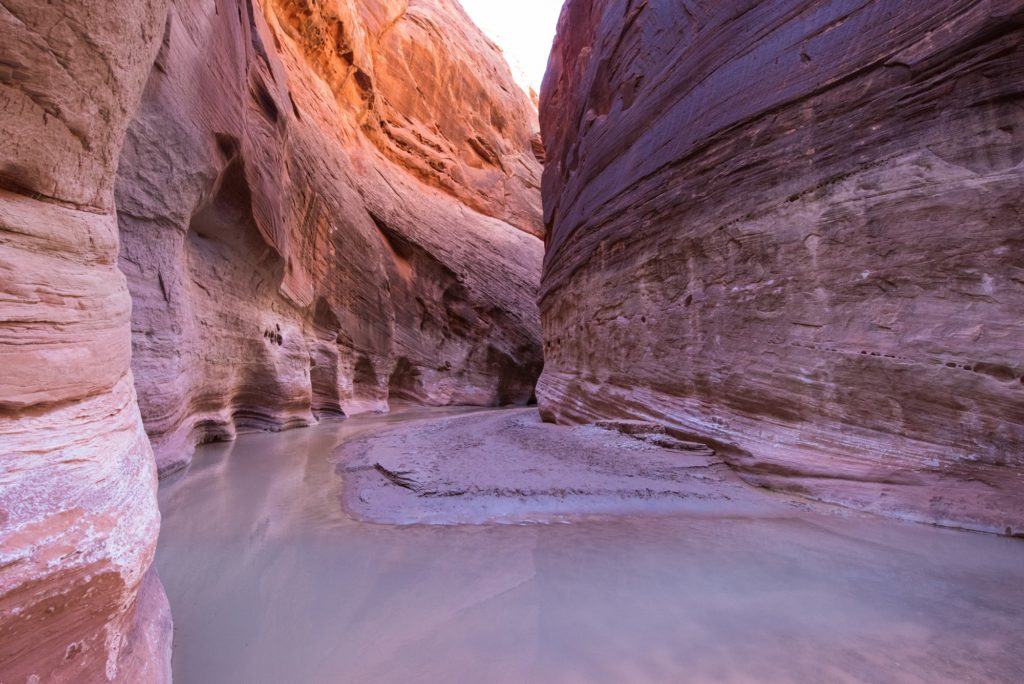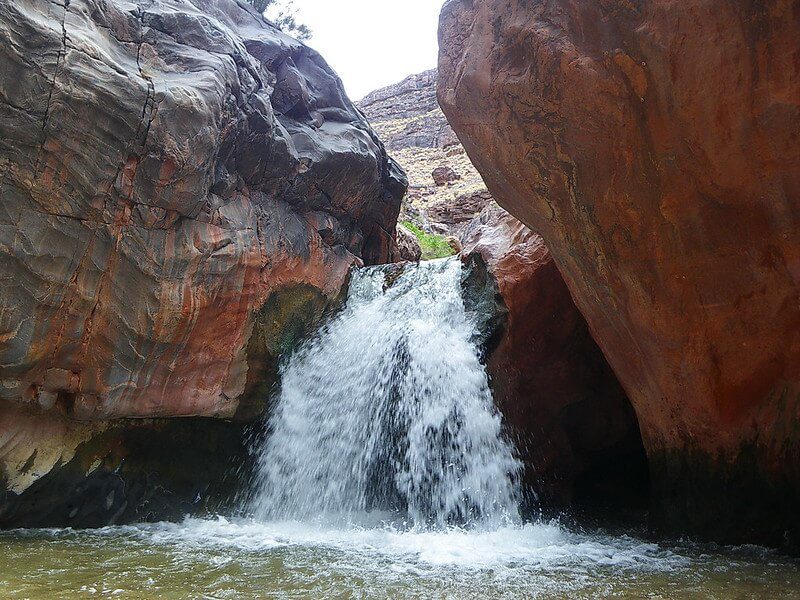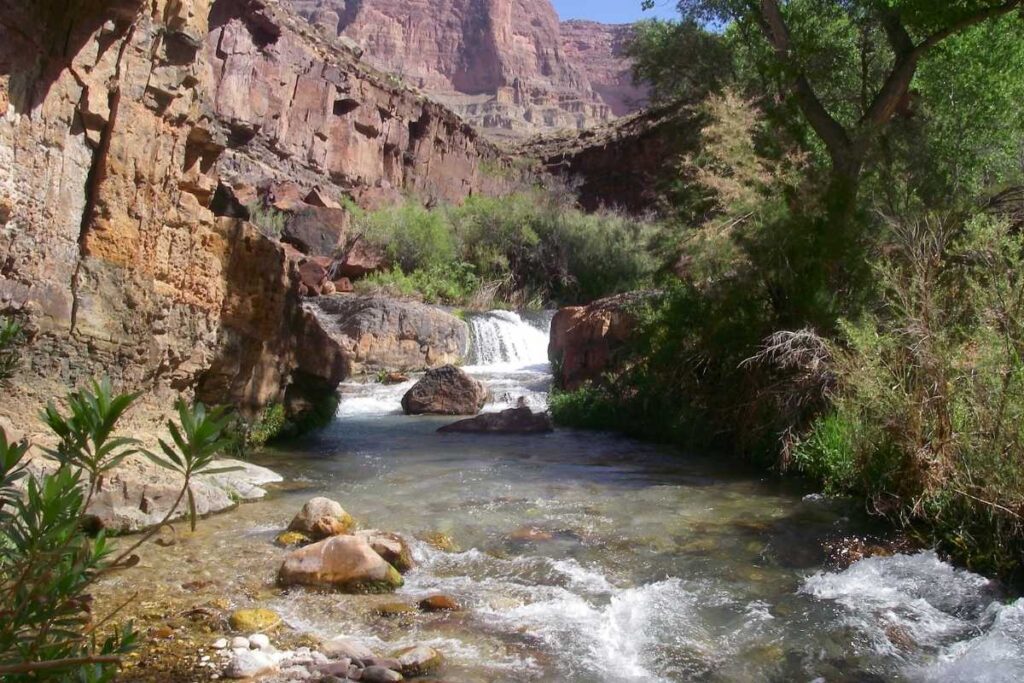The Grand Canyon is one of the most important natural wonders in the world. Rock formations can be seen from the river flowing below.
The river that runs through the Grand Canyon is the mighty Colorado River. The Colorado River is one of the major rivers in the United States. Besides the Colorado river, several tributary rivers are also in the Grand Canyon area.
Table of Contents
- The Colorado River Runs Through The Grand Canyon
- Length Of The Grand Canyon Explored
- Virtually Travel The Grand Canyon With Conquer Virtual Challenges
- Related Questions
The Colorado River Runs Through The Grand Canyon
The Colorado River is the main river that runs through the Grand Canyon. The river starts at Lake Powell in northern Arizona and southern Utah.
The Colorado River goes through the Grand Canyon to Lake Mead, which is located in Arizona and Nevada. Lake Mead is also where the Hoover Dam is located.
Lake Powell and Lake Mead are at some of the lowest levels they have ever been, which concerns many conservationists. Most of the water flow for the Colorado River in the Grand Canyon originates from the Rocky Mountains region. If the Rocky Mountains do not have a lot of snowfall, it can affect the water levels.
Facts About The Colorado River And Grand Canyon
The Colorado River is a major river in the United States. The river runs through the entire Grand Canyon area; it is a significant river for the United States, especially in the western states.
Here are some facts about the Colorado River:
- Sixth Longest River – The Colorado River is the sixth-longest river in the United States. It is 1,450 miles long.
- Goes Through Seven States And Two Nations – The Colorado River and its Tributary rivers go through seven states (Wyoming, Colorado, Utah, New Mexico, Arizona, Nevada, and California) and two nations (the United States and Mexico).
- Flows Through 11 National Parks And Monuments – The Colorado River flows through 11 National Parks and several monuments.
- Divided Between Upper And Lower Basin – In 1922, the Colorado River Water Compact divided the Colorado River into upper and lower basin areas.
- Lake Powell And Lake Mead Are On the River – Lake Powell in southern Utah and northern Arizona and Lake Mead in Northern Arizona and Nevada are on the Colorado River.
- Dams Are Located On The River – There are several dams located on the Colorado River. Most notably the Glen Canyon Dam in northern Arizona and the Hoover Dam in Nevada.
Over the years, the Colorado River has been shrinking, especially in the lower basin area. Major water cuts will need to take place to save the water still left in the Colorado River.
Major Creeks And Rivers That Run Through Or Near The Grand Canyon
Besides the Colorado River, some smaller creeks come off the Colorado River and into parts of the Grand Canyon. Some of these creeks include:

- Paria River – The Paria River is located near Lee’s Ferry. It is about 95 miles or 153 kilometers long. It flows through Southern Utah and northern Arizona.

- Bright Angel Creek – Bright Angel Creek is located at the bottom of the Grand Canyon National Park; the creek flows into the Colorado River. It is also on the north side of the North Kaibab Trail on the north side of the river.

- Shinumo Creek – Shinumo Creek is also a famous creek at the Grand Canyon for camping and walking the creek area. Shinumo Creek also has a Shinumo Creek Waterfall.

- Tapeats Creek – Tapeats Creek is also located in the Grand Canyon National Park. The Tapeat Creek is fed from the Tapeats Springs, the largest spring in the Grand Canyon.

- Kanab Creek – Kanab Creek starts in Kane County, Utah, then flows south into the Colorado River. There is a crossing at the creek that is known as Nagles Crossing.

- Havasu Creek – Havasu Creek is a northern Arizona stream associated with the Havasupai people. It is a tributary of the Colorado River.

- Diamond Creek – Diamond Creek is a stream that flows from the Hualapai tribal reservation, or Peach Springs, Arizona, to the Colorado River in the Grand Canyon.
Colorado is the major river that flows through the Grand Canyon Area. Still, besides the Colorado River, many smaller rivers or creeks flow from the Colorado River throughout the Grand Canyon.
Length Of The Grand Canyon Explored
The Colorado River runs right through the Grand Canyon; you can raft down the river, and there are many guides and rafting tours. The total distance of the river in the Grand Canyon is 277 miles long, or 277 river miles long.
But walking the Grand Canyon would take you much longer, or about 277 miles to hike the Grand Canyon; most of the area has no trails, so walking is almost impossible.
That is why most prefer to raft or take a fly-over tour of the Grand Canyon area. The Grand Canyon covers a vast area of northern Arizona.
Very few people have ever walked the entire Grand Canyon, which is difficult. And most have not gone the whole mile.
As Peter Mc Bride, the National Geographics Photographer, pointed out in talking about people walking the Grand Canyon:
“Less than a dozen have done it without stopping, in the history of the world—that we know of. There’s a reason way beyond that there’s no trail for 90 percent of it.”
Pete McBride
Walking the entire Grand Canyon is very difficult. Even for the fittest hikers and walkers, it could take them several months to complete the journey.
Virtually Travel The Grand Canyon With Conquer Virtual Challenges

Most of us will not take the months of hardship required to walk the entire length of the Grand Canyon. But there is a way that you can do it virtually; along the way, you can see some of the views of the Grand Canyon through Google Earth.
I love the Conquer Virtual Challenge app, as not only does it help me to have every single mile count towards a challenge, but it also helps me keep my fitness goals on track.
You can do the hike, walk, cycle, or whatever you want to log in with a group of friends and family or alone with your new Conquer Virtual Challenge friends who are also doing the same challenge.
When you complete your Grand Canyon or another challenge, you get sent a medal sent to you by the Conquer Virtual Challenge, a great way to show that you finished the distance.
To find out more and to get 10% off your Grand Canyon Challenge or another Virtual Conquer Challenge, click on the link below:
At A Bus On A Dusty Road, we talk about travel, life, and ex-pat living. We are all about “Living Life As A Global Citizen.” We explore social, cultural, and economic issues and travel.
We would love to have you be part of our community. Sign up for our newsletter to keep up-to-date by clicking here. If you have any questions, you can contact me, Anita, by clicking here.
Listen to our Podcast called Dusty Roads. You can find it on all major podcast platforms. Try out listening to one of our podcasts by clicking here.
Subscribe to our A Bus On A Dusty Road YouTube Channel with great videos and information by clicking here.
Related Questions
Is A Day Trip To The Grand Canyon Worth It?
If you only have one day to visit the Grand Canyon, it is still worth visiting. You can do things to prepare for your trip so that you will have the most time available. We recommend you go to see the South Rim area of the Canyon.
By clicking here, you can discover Is A Day Trip To The Grand Canyon Worth It?.
How Big Is The Grand Canyon? & Other Grand Canyon Questions
The Grand Canyon area is 277 miles long or about 1,904 square miles. It is a vast area that will take you 5 hours or 215 miles to travel from the North Rim to the South Rim of the Grand Canyon. Most of the area does not have hiking or other trails. As the Grand Canyon took about 6 million years to create, it is one of the world’s natural wonders.
By clicking here, you can discover How Big Is The Grand Canyon? & Other Grand Canyon Questions.
Was The Grand Canyon Once Totally Filled With Water? & More
The Grand Canyon was once filled with water, but the Grand Canyon itself is at least 6 million years old. The rock and rock formations of the Grand Canyon help us to tell the story of this magnificent place on earth.
By clicking here, you can discover Was The Grand Canyon Once Totally Filled With Water? & More.

